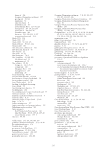159 18 River and wetland health in the Lake Eyre Basin – an economic perspective Mark Morrison Introduction Many of the world’s natural resources form part of the economic sphere, and rivers and wetlands are no exception. For example, considerable amounts of the world’s water resources are diverted for irrigated agriculture, providing economic value through production of food and fibre. Many mining developments also use water resources in their production. There are also social, economic and environmental costs of such developments which are often not well accounted for these are described as externalities and can be a cause of market failure. Economists include the environment in economic assessments by deriving monetary values. This requires estimation of values for changes in environmental quality, which is often a difficult challenge as natural resources are typically not traded in markets but many policy decisions are influenced by economic values. Rivers and wetlands and their dependent biodiversity have values which need to be measured to provide an open and transparent recognition of the impacts of economic development activities. For example, a key question for the Lake Eyre Basin rivers is to identify the costs and benefits of irrigation or mining developments, two of the highest profile potentially deleterious developments affecting the rivers. There are no economic valuations of the rivers and wetlands in the Lake Eyre Basin, but there is increasing understanding of the importance of identifying the economic value of changes to environment quality in developed rivers. Consequently, I use current understanding of the economic values of the environment for the developed nearby Murray– Darling Basin to illustrate the magnitude of likely values in the Lake Eyre Basin. Economic values of the environment There are two types of economic values for the environment: use and non-use values (Morrison and Hatton-MacDonald 2010). First, use value comes from using a good (e.g. water) either directly or indirectly. For example, direct use includes recreation by locals and tourists to the river (see Chapter 13), and amenity value from living near an environment in good condition. Direct use also includes commercial fishing and grazing livestock on the rivers and floodplains of the Lake Eyre Basin (Fig. 18.1 see Chapters 10 and 11). Indirect use values reflect the indirect benefits to people from environmental quality. This might include the organisms in the environment. For example, waterbirds may help control locust plagues trees provide shade for livestock and wetlands improve water quality. These direct and indirect use values are often called ecosystem service values.
Downloaded from CSIRO with access from at 216.73.216.220 on Oct 28, 2025, 7:04 PM. (c) CSIRO Publishing

















































































































































































































































































